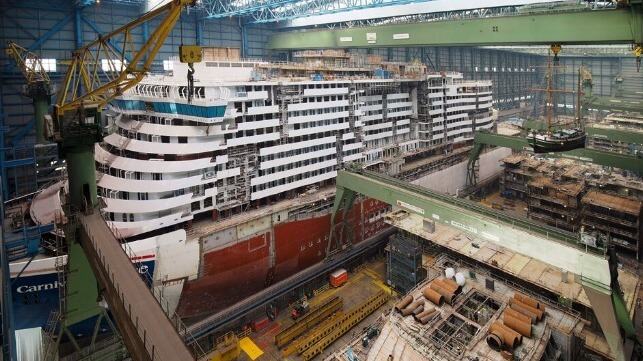Carnival Corp. Slows Newbuilds as Rebound in Operations Continues

Carnival Corporation is implementing a fleet optimization strategy that involves the continuing sale of smaller, less efficient cruise ships and curtailing newbuilding expenditures from 2026. The corporation reports that it plans to decelerate its newbuilding pace as one of several steps to lower costs as it continues to rebuild its global cruise operations and looks to reduce debt built up during the pandemic.
With the fleet optimization efforts, Carnival Corporation now expects total capacity growth of just three percent in 2023 compared to the peak period of 2019, a downward revision from a previous guidance range of three percent to five percent growth in capacity. Nearly a quarter of the company’s capacity however will be on vessels that have been recently delivered as it added new ships at Carnival Cruise Line, Holland America Line, P&O Cruises, and Seabourn after selling approximately two dozen older ships mostly in 2020 during the pause in operations due to the COVID-19.
“We have just four ships on order through 2025, plus our second incredible Seabourn luxury expedition ship to be delivered in 2023,” Josh Weinstein, Carnival Corporation President and CEO told investors during a recent briefing. “This is our lowest order book in decades. We don’t expect any new ships in 2026 and anticipate just one or two new builds each year for several years thereafter.”
Carnival Corporation announced in its fourth quarter financial report that while the capital expenditure for newbuilds next year will amount to $1.8 billion, it is projected to increase to $2.4 billion in 2024 before drastically declining to $900 million in 2025. Starting in 2026, the company currently has no additional capital expenditures scheduled for on newbuilds. Capital expenditure on non-newbuilds will amount to $1.6 billion in 2023 and remain constant at $1.7 billion over the next three consecutive years.
Over the next three years, the cruise corporation that currently operates a fleet of approximately 95 ships expects to take delivery on a total of four large cruise ships and one additional cruise ship for expedition voyages. This comes after completing the orders for AIDA, Costa, Holland American and P&O. Meyer Werft is completing the Carnival Jubilee due to enter service in December 2023. Fincantieri is building three large cruise ships, Princess Cruises’ Sun Princess due in February 2024, Cunard’s Queen Anne due to enter service in May 2024 and an unnamed sister ship to the Sun Princess due to enter service in July 2025. The Seabourn Pursuit is a smaller ship for expeditions due to enter service in April 2023.
Carnival Corporation, like all of the major cruise lines, has not placed a new cruise ship construction order since the onset of the pandemic. The cruise company however also is participating in a joint venture with China that is due to launch a new domestic Chinese brand and the first large Chinese-built cruise ship in 2024.
While new ship deliveries have continued, Carnival Corporation also accelerated the removal of older, less efficient ships from its brands. During the latest briefing, management said they expect to remove three additional smaller, less efficient ships from the overall fleet, including two more from Costa Cruises as part of the company's strategy to right-size the brand in light of the continued closure of cruise operations in China. Once the process of fleet optimization strategy is completed in 2024, the company will have reduced Costa's capacity so that it approximates the 2019 capacity Costa dedicated outside of Asia to its core markets in continental Europe.
Carnival Corp’s decision to drastically cut down on capital expenditure is the latest move in a series of measures focusing on cost cutting to strengthen its balance sheet. In the fourth quarter, the company posted a $1.6 billion after tax loss, an improvement from $2.6 billion last year. Full-year losses amounted to $6.1 billion, an improvement from last year's losses of $9.5 billion.
During the year, the company saw a significant surge in revenues to $12.1 billion compared to $1.9 billion in 2021 but its debt stands at $31.9 billion as of November compared to $28.5 billion in the same period last year.
According to Weinstein, the company is witnessing a return to normalcy after the COVID-19 disruptions after managing to return nearly all of its fleet to service during the year, aggressively building occupancy on growing capacity and driving revenue per passenger.
“Booking volumes strengthened following the relaxation in protocols, cancellation trends are improving globally, and we have seen a measurable lengthening in the booking curve across all brands,” he said.
Carnival Corp expects occupancy for the first quarter of 2023 to be 90 percent or slightly higher, representing a further improvement from approximately 84 percent in the fourth quarter. Carnival Corporation projects occupancy levels for its overall operation to return to historical levels at or above 100 percent in the summer of 2023.
